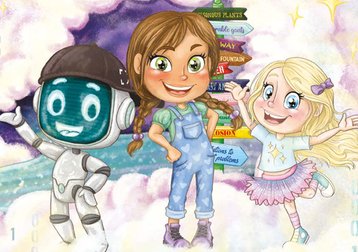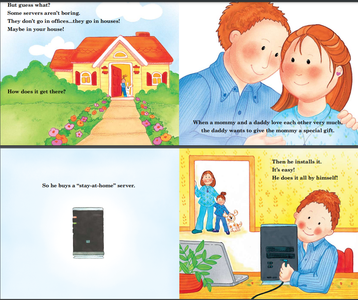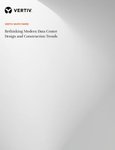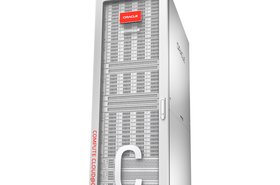A couple of weeks ago, Digital Realty brought out a somewhat different piece of marketing collateral… aimed at children.
Adventures in the Cloud World is a downloadable e-book for children aged 6 to 12, which aims to “teach the next generation about data centers and technology.” It follows two kids called Bella and Nini, who go to “Cloud World” after their WiFi turns off at home and, supposedly come back with a better understanding of the technology behind the Internet.
I’m afraid my first response was to laugh. The book has tiny print, there didn’t seem to be much actual explaining in it, and I couldn’t imagine reading an e-book to kids. I thought: have these people even met any children?
Inspiring the next Grace Hopper?
But the author, Digital’s comms manager in the Netherlands Melissa Scholten, has children. So does CEO Andy Power, who says: “There are plenty of children’s books about superheroes, musicians, and athletes…we want to inspire the next Grace Hopper, Marie Curie, and Annie Easley, and bridge the gap in those who continue to study STEM subjects beyond high school."
Digital has backed this by translating the book into five other languages. On LinkedIn, numerous people praised it, saying they had read it to their children. We can dismiss some of that as social media fluff, but some adults (and possibly some children) apparently like it.
It’s many years since I read a book to my children, and it’s definitely true that there aren’t enough youngsters taking science and technology seriously. Could books help inspire them?
Jobs-wise, really young kids have Postman Pat and Bob the Builder. There is also STEM material such as for Baby University, and Baby Loves Science, which includes Baby Loves Coding.
Aiming at the same age range as Digital Realty, we have Kate the Chemist by real-life chemistry professor Kate Biberdorf, and probably a bunch more. When I was young, I remember Norman Hunter’s Professor Branestawm, whose inventions were drawn by Heath Robinson. Dr. Doolittle was another science hero, and there were some nifty Puffin books like The Case of the Silver Egg, by Desmond Skirrow.
I haven’t got young children to test it on, but in my reading, Cloud World has a lot of flaws.
The two kids can’t play their VR game because the Internet connection is lost. They check all the plugs and can’t find what’s wrong with the WiFi, so they get in a magic (self-driving) flying car to visit the magic “cloud world,” a literal magic cloud full of 1s and 0s, where a robot called JB needs them to plug in a cable to fix the Internet. They return, to find their parents haven’t missed them.
There are some jokes about flip phones, and the kids help JB who can’t click the “I’m not a Robot” button. There’s a spread of data center technology images that doesn’t link to the story, but mostly the story treats tech as magic, which is a bit of a pitfall in a book like this.
Still, I’ve been told on LinkedIn that you shouldn’t expect a book to “teach” children about science. At this age, it is more about “playing," and anything that gets them reading and interested in things is good.
As the author put it: “By introducing children to the world of IT and data centers, we hope to get them curious and generate interest about a crucial sector.”
Done right, such efforts could do their bit to help solve the workforce crisis and diversity challenge over the long term.
Has anyone done it well?
There are other examples where the sector has gotten playful and curious, with different results. In 2007, Microsoft did a lovely pastiche children’s picture book called “Mommy, Why is There a Server in the House?” archived here.
It was a joke for adults, rather than a genuine educational effort, and designed to promote Windows Home Server, which was a NAS drive that Microsoft discontinued in 2011. But you have to like a book that contains the immortal line: “When a mommy and a daddy love each other very much, the daddy wants to give the mommy a special gift. So he buys a ‘stay-at-home’ server.”
If you want a really dry introduction to data centers, get over to Kao Academy - an effort launched in 2022 by Kao Data in collaboration with the Cambridge Science Centre - which has a word search and a cut-out-and-stick model that teaches children that a data center is the world’s least exciting building.
The leader in this sparse field is probably Eaton’s classic “What is a data center?” from 2021, in which a family of honey badgers visit the data center where the parents work. Why honey badgers? An industry poll chose them, Boaty McBoatface style, thanks to a video that branded them as the most “crazy nastyass” creatures on earth.
Sadly, the honey badgers endure a very non-crazy, un-nastyass tour of a data center, including parking lots, mantraps, and UPS. I doubt this book ever got read to children, but it does include a lot of pop-cultural references to stop the adults from falling asleep.
And it is part of a series including the much more entertaining Mostly Untrue History of Rack PDUs.
What do we learn from all this? Data center people find it hard to talk to children about data centers.
I suspect this is because, deep down, even data center people struggle to talk about data centers.






